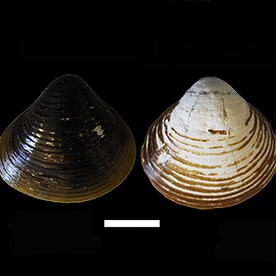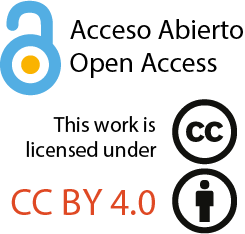TAPHONOMY OF DEATH ASSEMBLAGES OF THE FRESHWATER BIVALVE CORBICULA FLUMINEA (MÜLLER, 1774) (VENEROIDEA) AFTER THREE AND FOUR DECADES IN THE UPPER RÍO DE LAPLATA, URUGUAY
Tafonomía de los ensambles de valvas del bivalvo invasor Corbicula fluminea (Müller, 1774 (Veneroidea) luego de tres y cuatro décadas de su registro en el Alto Río de La Plata, Uruguay
DOI:
https://doi.org/10.5710/PEAPA.16.07.2025.538Keywords:
Actualistic Taphonomy, Death assemblage, Corbicula fluminea, Río de la Plata, UruguayAbstract
The invasive bivalve Corbicula fluminea has been known in the Río de la Plata for approximately 40 years. This decadal time lapse fill a gap in taphonomic studies. Our study is the second to investigate taphonomic modifications on valves of this species in Uruguay, expanding the temporal resolution of the first. We divided the valve into four sectors and recorded fragmentation, periostracum loss, and corrasion, categorizing these attributes into three severity levels. We also observed no attempts at bioerosion and bioencrustation. The central sector is the most frequent among all samples, and the posterior one is the least frequent. The differences in damage were tested using the X2 test, the Bonferroni correction, and an average taphonomic score. We evaluated the extent of taphonomic damage over time by comparing the average taphonomic score using Kendall’s tau. The tests revealed several statistically significant differences. The umbonal and posterior sectors are differently represented, with the 2008 sample being different in both cases. The central and anterior sectors do not exhibit differences. Fragmentation exhibits differences in all sectors except the anterior over the years; category 0 is the most represented in all years and sectors. Periostracum damage shows no statistically significant differences in sectors or years; category 2 is the most represented. Corrasion differs among the three samples, varying over the years in different sectors; category 2 is the most represented. In conclusion, there are statistically significant differences in the sectors represented and in fragmentation. However, no linear trend was observed over the years.
References
Antuña, D., Cabrera, F., Rojas, A. and Martínez, S. (2021). Tafonomía Actualista en el gasterópodo invasor Rapana venosa (Valenciennes, 1846) en el estuario del Río de la Plata. Boletín de la Sociedad Zoológica del Uruguay, 30, e30.2.11. https://doi.org/10.26462/30.2.11
Best, M.M.R. and Kidwell, S.M. (2000a). Bivalve taphonomy in tropical mixed siliciclastic-carbonate settings: I. Environmental variation in shell condition. Paleobiology, 26, 80–102. https://doi.org/10.1016/0031-0182(92)90142-R
Best, M.M.R. and Kidwell, S.M. (2000b). Bivalve taphonomy in tropical mixed siliciclastic-carbonate settings: II. Effect of bivalve life habitats and shell types. Paleobiology, 26, 103–115. https://doi.org/10.1666/0094-8373(2000)026%3C0103:BTITMS%3E2.0.CO;2
Briggs, D.E.G. (1995). Experimental Taphonomy. Palaios, 10, 539–550. https://doi.org/10.2307/3515093
Cadée, G.C. (2003). Heeft de korfmossel Corbicula ook predators in de Rijn?. Spirula, 334, 112–113.
Cadée G.C. and Soes, D.M. (2004). Corbicula fluminea (Müller, 1774) (Bivalvia, Corbiculidae) eaten by oystercatchers. Basteria, 68, 87–90. https://natuurtijdschriften.nl/pub/597280/BAST2004068004004.pdf
Chattopadhyay, D., Rathie, A. and Das, A. (2013). The effect of morphology on postmortem transportation of bivalves and its taphonomic implications. Palaios, 28, 203–209. https://doi.org/10.2110/palo.2012.p12-103r
Checa, A. G. (2018). Physical and biological determinants of the fabrication of molluscan shell microstructures. Frontiers in Marine Science, 5, 356766. https://doi.org/10.3389/fmars.2018.00353
Checa, A.G. and Rodríguez-Navarro, A. (2001). Geometrical and crystallographic constraints determine the self-organization of shell microstructures in Unionidae (Bivalvia: Mollusca). Proceedings of the Royal Society of London. Series B: Biological Sciences, 268, 771–778. https://doi.org/10.3389/fmars.2018.00353
Clavijo, C. (2021). 40 años después: bivalvos del género Corbicula en Uruguay. In A. Brazeiro, D. Bresciano, E. Brugnoli and M. Iturburu (Eds.), Especies exóticas invasoras de Uruguay: distribución, impactos socioambientales y estrategias de gestión (pp. 163–170). Retema-UdelaR/CEEI, Ministerio de Ambiente.
Erthal, F. and Ritter, M. (2017). Tafonomia Atualística: conceitos e aplicaçoes. In: R.S. Horodyski and F. Erthal (Eds.), Tafonomia: Métodos, Processos e Aplicação (pp. 29–79). Editora CRV.
Evia, G. and Gudynas, E. (2000). Ecología del paisaje en Uruguay. Sevilla, España: Junta de Andalucía - Ministerio de Vivienda, Ordenamiento Territorial y Media Ambiente – Agencia Española de Cooperación Internacional.
Flessa, K. W. (1993). Time-averaging and temporal resolution in Recent marine shelly faunas. In S.M. Kidwell and A.K. Behrensmeyer (Eds.), Taphonomics approaches to time resolution in fossil assemblages (pp. 9–33). Short Courses in Paleontology, 6. Paleontological Society.
Flessa, K.W. and Brown, T.J. (1983). Selective solubility of macroinvertebrate calcareous hard parts: a laboratory study. Lethaia, 16, 193–205. https://doi.org/10.1111/j.1502-3931.1983.tb00654.x
Flessa, K.W., Cutler, A.H. and Meldahl, K.H. (1993). Time and taphonomy: Quantitative estimates of time-averaging and stratigraphic disorder in a shallow marine habitat: Paleobiology, 19, 266–286. https://doi.org/10.1017/S0094837300015918
Fritz, L.W., Calvo, L.M., Wargo, L. and Lutz, R.A. (2022). Seasonal changes in shell microstructure of some common bivalve molluscs in the Mid-Atlantic region. Journal of Shellfish Research, 41, 1–59.
Gómez, M.C., Rojas, A. and Martínez, S. (2021). Taphonomy of a death assemblage of the invasive bivalve Corbicula fluminea (Müller,1774), upper Rio de la Plata, Uruguay. Boletín de la Sociedad Zoológica del Uruguay, 30, e30.2.3. https://doi.org/ 10.26462/30.2.3
Gómez Maduro, M.C, Rojas, A. and Martínez, S. (2023). Taphonomic signatures in dead shells of the invasive gastropod Rapana venosa (Valenciennes, 1846) after two decades in the Río de la Plata, Uruguay. Palaios, 38, 136–147. https://doi.org/10.2110/palo.2021.070
Hammer, Ø., Harper, D.A.T. and Ryan, P.D. (2001). PAST: Paleontological Statistics Software Package for Education and Data Analysis. Palaeontologia Electronica, 4, 1–9. http://palaeo-electronica.org/2001_1/past/issue1_01.htm
Harper, E. M. (1997). The molluscan periostracum: an important constraint in bivalve evolution. Palaeontology, 40, 71–98.
Ituarte, C.F. (1982). Contribución al conocimiento de la biología de la familia Corbiculidae (Mollusca: Pelecypoda) en el Río de la Plata. [Doctoral Thesis 408, Universidad Nacional de La Plata].
Kidwell, S.M. and Bosence, D.W.J. (1991). Taphonomy and time-averaging of marine shelly faunas. In: P.A. Allison and D.E.G. Briggs (Eds.), Taphonomy: Releasing the data locked in the fossil record (pp. 115–209). Plenum Press.
Kosnik, M.A., Hua, Q., Kaufman, D.S. and Wüst, R.A. (2009). Taphonomic bias and time-averaging in tropical molluscan death assemblages: differential shell half-lives in Great Barrier Reef sediment. Paleobiology, 35, 565–586. https://doi.org/10.1666/0094-8373-35.4.565
Kotzian, C.B. and Simões, M.G. (2006). Taphonomy of recent freshwater molluscan death assemblages, Touro Passo Stream, southern Brazil. Revista Brasileira de Paleontologia, 9, 243–260.
Kroboth, P.T., Stahlschmidt, B.H. and Chapman, D.C. (2024). Black Carp Mylopharyngodon piceus (Richardson, 1846) mouth gape and size preference of a bivalve prey. Journal of Applied Ichthyology, 5551187. https://doi.org/10.1155/2024/5551187
Kusnerik, K.M, Means, G.H., Portell, R.W., Brenner, M., Hua, Q., Kannasi, A., Means, R., Monroe, M.A. and Kowalewski, M. 2020 Live, dead, and fossil mollusks in Florida freshwater springs and spring-fed rivers: Taphonomic pathways and the formation of multi-sourced, time-averaged death assemblages. Paleobiology, 46, 356–378. https://doi.org/10.1017/pab.2020.25
López Laborde, J. (2003). Caracterización y diagnóstico del litoral costero sobre el Río de la Plata y el Océano Atlántico (Nueva Palmira a Chuy). [Informe Técnico Freplata].
Martínez, S., Rojas, A. Cabrera, F. and Antuña, D. (2020). Alien species, a natural experiment in Actualistic Taphonomy. In S. Martínez, A. Rojas and F. Cabrera (Eds.), Actualistic Taphonomy in South America (pp. 61–68). Springer Editors.
Meldahl, K.H., Flessa, K.W. and Cutler, A.H. (1997). Time averaging and postmortem skeletal survival in benthic fossil assemblages: quantitative comparisons among Holocene environments. Paleobiology, 23, 207–229. https://doi.org/10.1017/S0094837300016791
Newell, A. J., Gower, D. J., Benton, M. J. and Tverdokhlebov, V. P. (2007). Bedload abrasion and the in situ fragmentation of bivalve shells. Sedimentology, 54, 835–845. https://doi.org/10.1111/j.1365-3091.2007.00862.x
Parsons, K.M. and Brett, C.E. (1991). Taphonomic process and biases in modern marine environments: An actualistic perspective on fossil assemblage preservation. In S.K. Donovan (Ed.) The Processes of Fossilization (pp. 22–65). Belhaven Press.
Pereira, L.G., Fornari, M., Erthal, F., Leme, J.M. and Giannini, P.C.F. (2021). Multivariate taphonomic analysis of mollusk shell concentrations in Holocene deposits of southern Brazil: An integrated approach. Palaeogeography, Palaeoclimatology, Palaeoecology, 562, 110085. https://doi.org/10.1016/j.palaeo.2020.110085
Pla Ventura, M., Quiñonero Salgado, S., Hernández Núñez de Arenas, J., Velázquez Cano, J., Risueño Mata, P. and López Soriano, J. (2018). Predation of the blue crab Callinectes sapidus Rathbun, 1896 on freshwater bivalves (Unionidae & Corbiculidae) in eastern Iberian Peninsula. Folia Conchyliologica, 47, 3–9.
Powell, E.N., Stanton, R.J., Logan, A. and Craig, M.A. (1992). Preservation of Mollusca in Copano Bay, Texas: The long-term record. Palaeogeography, Palaeoclimatology, Palaeoecology, 95, 209–228. https://doi.org/10.1016/0031-0182(92)90142-R
Robinson, J.V. and Wellborn, G.A. (1988). Ecological resistance to the invasion of a freshwater clam, Corbicula fluminea: fish predation effects. Oecologia, 77, 445–452. https://doi.org/10.1007/BF00377258
Sanders, H. and Mills, D.N. (2022). Predation preference of signal crayfish (Pacifastacus leniusculus) on native and invasive bivalve species. River Research and Applications, 38, 1469–1480. https://doi.org/10.1002/rra.4023
Taylor, J.D. and Kennedy, W.J. (1969). The influence of the periostracum on the shell structure of bivalve molluscs. Calcification and Tissue Research, 3, 274–283. https://doi.org/10.1007/BF02058669
Tietze, E. and De Francesco, C.G. (2014). Taphonomic differences in molluscan shell preservation in freshwater environments from the Southeastern Pampas, Argentina. Palaios, 29, 501–511. https://doi.org/10.2110/palo.2014.019
Veitenheimer-Mendes, I. and Olazarri, J. (1983). Primeros registros de Corbicula Mergele, 1811 (Bivalvia, Corbiculidae), para el Río Uruguay. Boletín de la Sociedad Zoológica del Uruguay (N.S.), 1, 50–53.

Additional Files
Published
Issue
Section
License
Copyright (c) 2025 Sergio Martínez, Alejandra Rojas, María Cecilia Gómez

This work is licensed under a Creative Commons Attribution-NoDerivatives 4.0 International License.
Authors retain copyright and grant the journal right of first publication with the work simultaneously licensed under a Atribución/Reconocimiento 4.0 Internacional that allows others to share the work with an acknowledgement of the work's authorship and initial publication in this journal.















